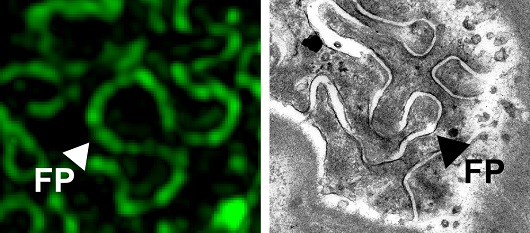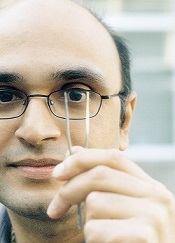New hope for kidney patients

A discovery, published this month in the journal Biomedical Optics Express, could allow doctors to diagnose kidney diseases faster and for less cost – using a new super-resolution microscope adapted by physicists at the University of St Andrews.
The breakthrough, achieved in collaboration with the Department of Pathology at Montefiore Medical Center and Albert Einstein College of Medicine, New York, could allow doctors a more efficient method for diagnosing nephrotic syndrome in the kidney – a group of debilitating and sometimes lethal diseases in which the kidney loses its ability to retain proteins in the blood, which are then carried into the urine.
Until now detection and treatment have relied on the use of an expensive and time-consuming electron microscope.
Now the St Andrews-NY team has developed an alternative light microscope which uses a patterned light-source to overcome physical laws of diffraction – allowing a doubling in what had been considered the maximum resolution possible using this technology.
In a new report, the team has shown for the first time that the super-resolution structured illumination microscope (SIM) can ‘see’ the critical changes in kidney cell processes which allow diagnosis of nephrotic diseases.
Conventional light microscopes have been used for almost two hundred years to visualise cells and diagnose disease in tissue. However the research has the potential to herald a new era in microscopy and could save lives as well as valuable resources.
 Professor Kishan Dholakia of the University of St Andrews (pictured) said: “This is an exciting advance and I’m very pleased by the synergy of our team of physicists, biologists and physicians to apply advances in optics for the diagnosis and treatment of kidney disease.”
Professor Kishan Dholakia of the University of St Andrews (pictured) said: “This is an exciting advance and I’m very pleased by the synergy of our team of physicists, biologists and physicians to apply advances in optics for the diagnosis and treatment of kidney disease.”
Dr James Pullman of the Montefiore Medical Center added: “It is important and exciting to show how advances in physics such as the SIM can benefit medicine and biology, and especially help people with kidney disease. I feel that our results represent the beginning of a new era in diagnostic pathology.”
The other authors of this work are Jonathan Nylk, Elaine C Campbell, Frank J Gunn-Moore and Michael B Prystowsky.
Notes to news editors
Image caption: Images of ultra-fine, diagnostically relevant features of [kidney/nephrotic] disease (foot processes; FP) imaged by [SIM/Structured illumination microscopy/St Andrews method] (left) compared against [electron microscopy/EM/the traditional diagnostic approach] (right). Scale bars are 1 micron in length.
The report is available at: https://www.osapublishing.org/boe/abstract.cfm?uri=boe-7-2-302
Issued by the University of St Andrews Communications Office, contactable on 01334 462530 or proffice@st-andrews.ac.uk.
Category Research